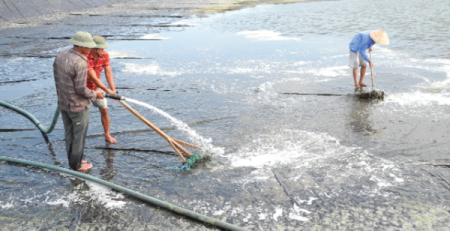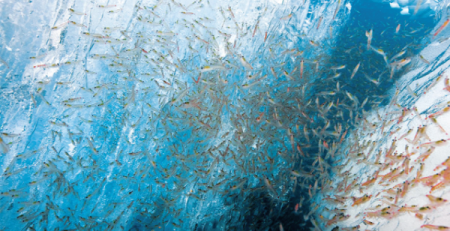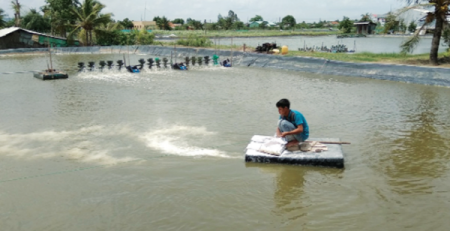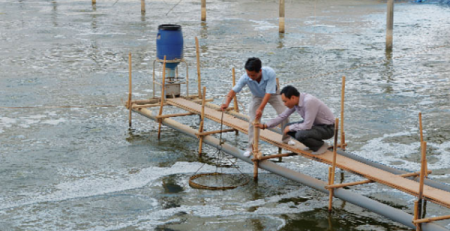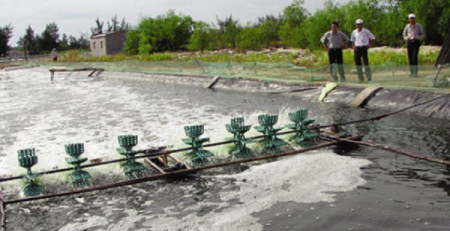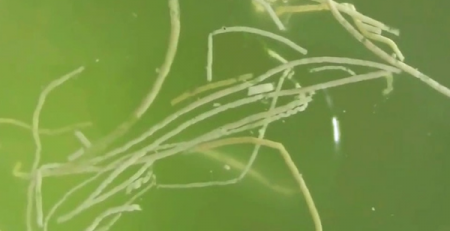Note when managing and taking care of the main shrimp farming
After stocking shrimps, the management of environment and health care of shrimp is the most basic technical stage, affecting the results of the crop.

In recent times, unpredictable weather conditions: Hot sunshine alternates with the rain, the difference between the day and night is the condition for viruses and bacteria to cause diseases for shrimp develope. In order to limit the negative impacts caused by the weather, shrimp farmers need to apply the following measures to stabilize the pond environment and increase the resistance of shrimp:
Nội dung bài viết [ẩn]
PH management:
pH is a volatile factor, especially after heavy rains, sudden fluctuations in pH can reduce shrimp resistance. Therefore, it is recommended to check the pH several times a day to make timely adjustments. Maintain the pH at an appropriate level from 7.5 to 8.5 and oscillate between light and dimension no more than 0.5 units. If the pH is low, farmers use lime from 10-20 kg / 1000m3 of pond water depending on the measured pH value.
In addition, to limit alum on the pond bank to wash down the pond when rain reduces pH and water turbidity, farmers should use lime stone CaO spread evenly on the pond edge. Lime will help neutralize acid to avoid sudden pH drop and help pond water not become cloudy after rain. In sunny days, algae thrive, pH increases, O2 decreases farmers need to apply water change, algae cutting to reduce the density of algae to avoid algal blooms.
Management of alkalinity:
Alkalinity is an important factor affecting the molting process of shrimps, slowing down shrimps, decreasing survival rate or often encountering prolonged soft shells due to lower alkalinity, especially for farming areas. low salinity. Alkalinity is suitable for tiger prawns from 80 – 140 mg / l and 120-150 mg / l for shrimp. If the alkalinity is low, use mineral products with the main component of CaCO3 with a dose of 20-30 kg / 1000m3.
Water level management:
For ponds with low water levels, the water quality will fluctuate greatly after the rain or hot weather. Therefore, it is necessary to maintain a minimum water level of 1.3 m for tiger shrimp ponds and 1.5 m for shrimp ponds. In addition, measures to enhance water fans during heavy rain or when the weather is severe will help to disturb the water to avoid stratification in the pond, thus limiting the negative impacts on farmed shrimp.
Limit pathogens in ponds:
By disinfecting pond water, in necessary cases such as the color of shrimp changes badly, shrimps close to the sea, close the viscous, bulging the tail, breaking the tail, breaking the beard … need to re-grow micro-organisms after 2 days to strengthen micro beneficial bacteria for the pond. Some biocides can affect shrimp health, therefore, farmers should pay attention to select relatively safe germicides and must check shrimp health before use.
Shrimp health management:
Regularly observe the reaction, color, intestinal, hepatopancreas and shrimp manure by checking feeding sieve and water color in the pond; Especially on the days when the weather is going badly, people need to fish shrimp every 5 – 7 days to check shrimp health and take timely measures when detecting abnormal signs such as weak shrimps, loose stools , intestinal mutilation, pancreatic liver faint, … In addition, farmers need to strengthen resistance to shrimp by strengthening supplements such as Vitamin C, minerals, intestinal microflora (digestive enzymes), Liver tonic, beta-glucan antagonist to increase resistance to shrimp in higher doses than usual.
Source: tepbac.com


